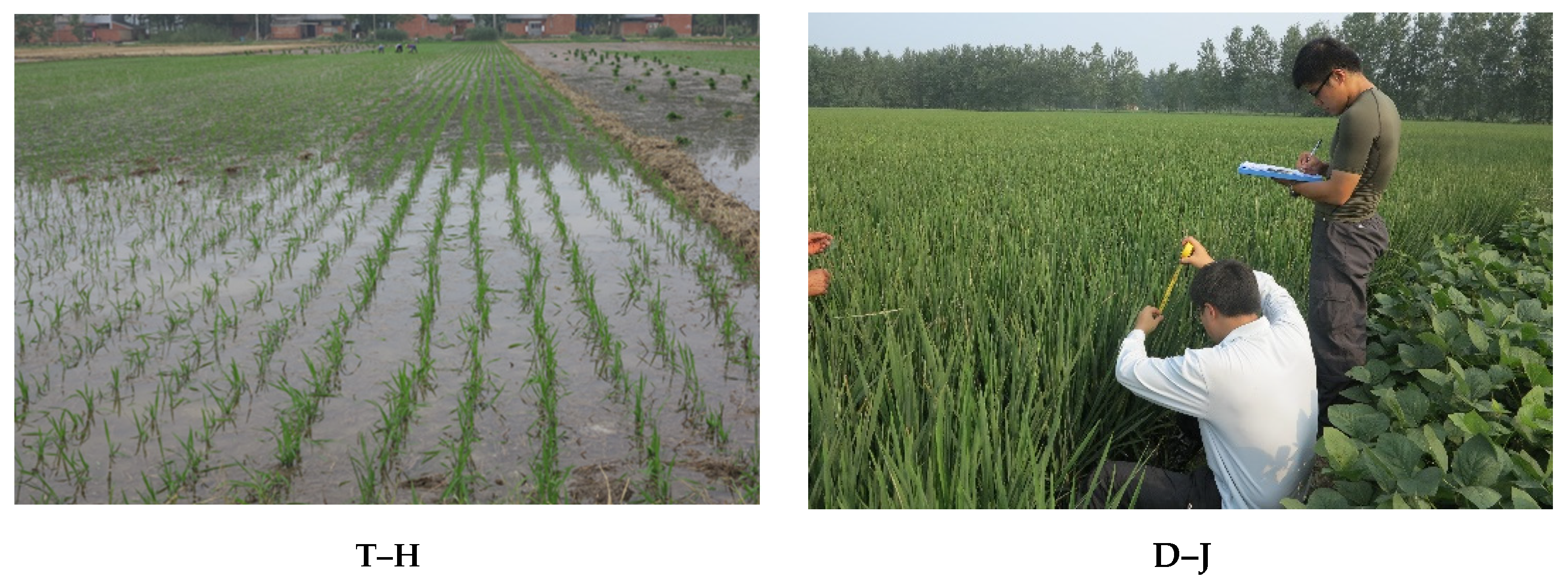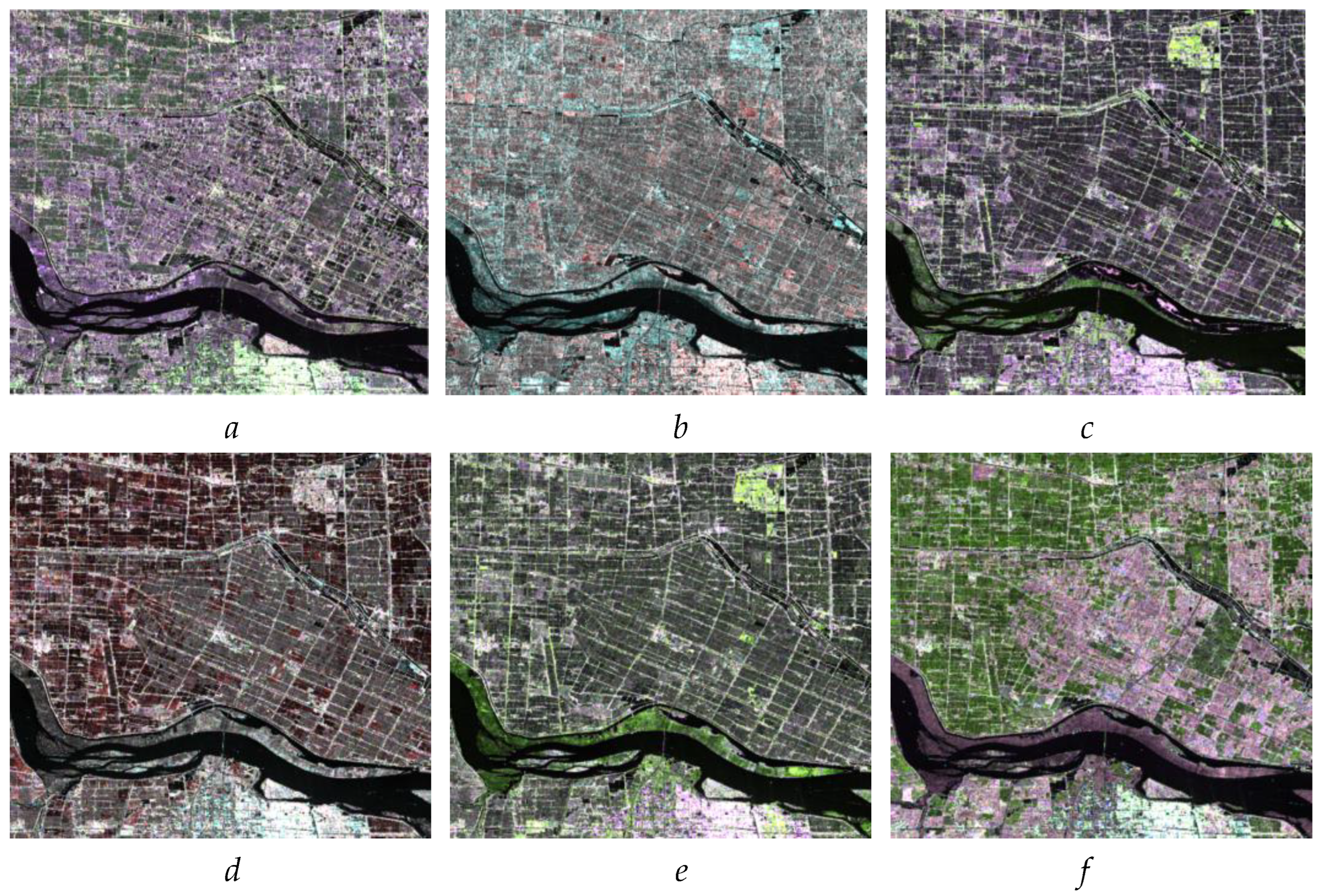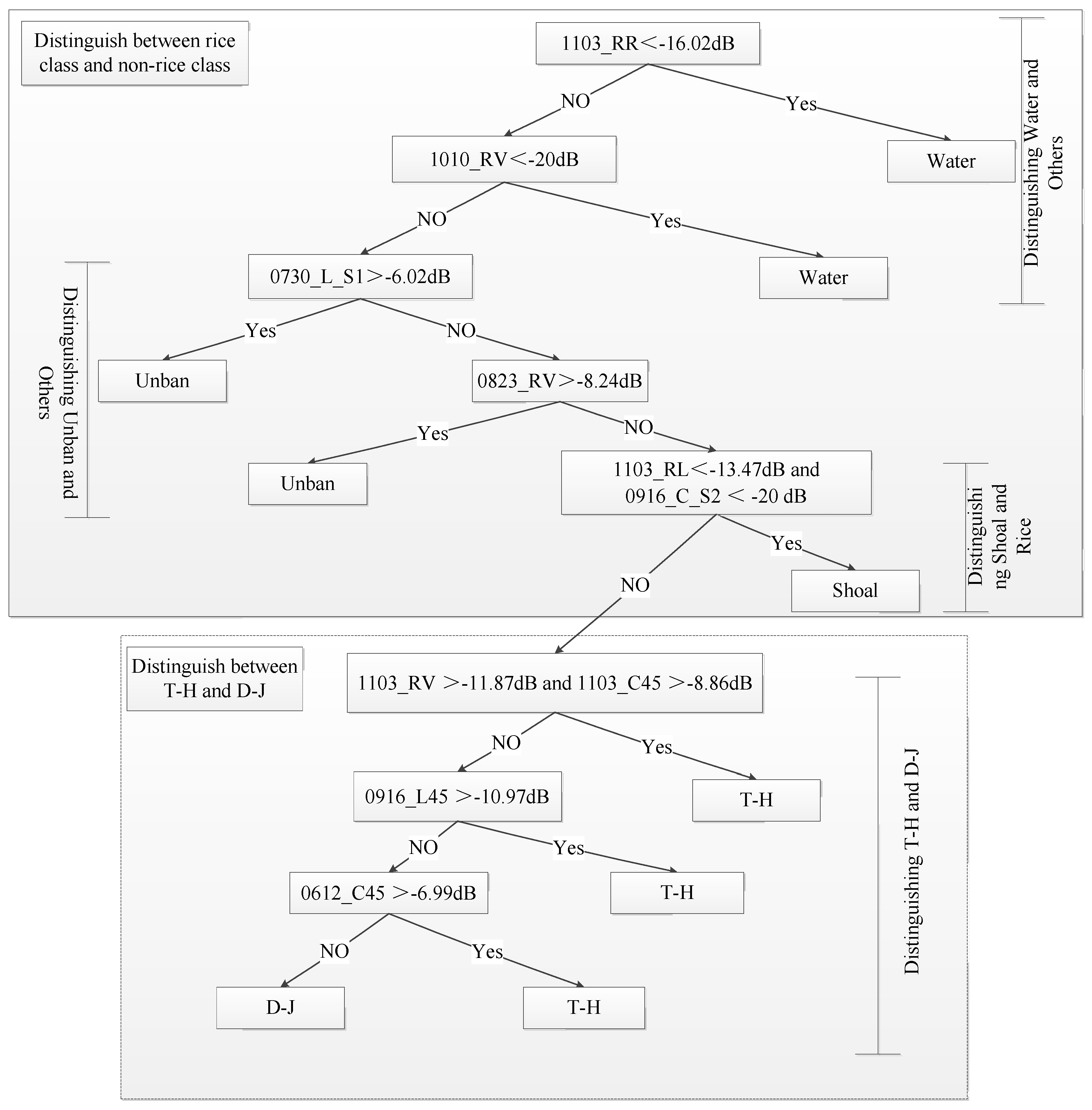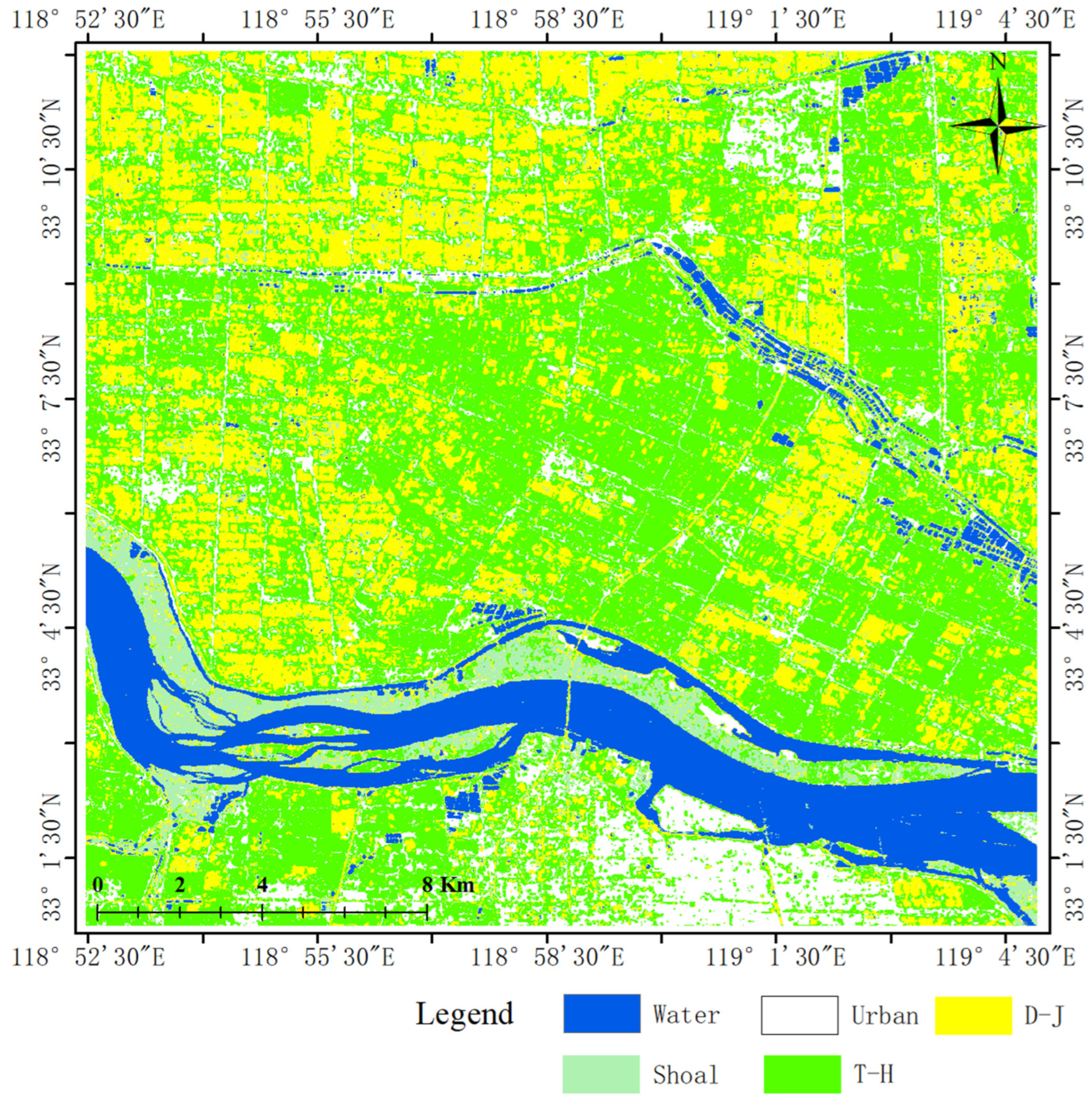Scattering Intensity Analysis and Classification of Two Types of Rice Based on Multi-Temporal and Multi-Mode Simulated Compact Polarimetric SAR Data
Abstract
:1. Introduction
2. Study Area and Data
3. Methodology
3.1. π/4 Mode and CTLR Mode
3.2. Stokes Vectors under Different CP Modes Are Simulated
3.3. The Backscattering Coefficients of Stokes Vector (SR, SL, and Sπ/4) Are Extracted
4. Results and Discussion
4.1. CP Parameters Analysis of Two Types of Rice under Six Periods
4.2. Building a Decision Tree Classification Model
4.3. Classification and Accuracy Verification
5. Conclusions
- (1)
- Through statistical analysis of the scattering intensities of CP parameters of six temporal CP SAR data under three transmitting modes, we found that CP parameters in the 1103 period (harvest stage) were the best parameters to distinguish between the two types of rice, followed by 0730 (seedling–elongation stage), 0612 (seedling stage), and 0916 (heading–flowering stage) periods. Moreover, CP SAR parameters in 0823 (booting–heading stage) and 1010 (dough–mature stage) periods were not obvious to be able to distinguish between T–H and D–J;
- (2)
- Firstly, in the CP SAR parameters of the three modes during the 1103 period, 1103_C45, 1103_LV, and 1103_RV were the most obvious to distinguish T–H and D–J. Secondly, in the CP SAR parameters under three transmitting modes during the 0730 period, 0730_CL, 0730_LL, and 0730_RL were also obvious to distinguish T–H and D–J. As can be seen from the optimal parameters of the 0730 period, all three CP parameters were for the best for the case of left circular polarization reception. In addition, in the 0612 period, 0612_C45, 00612_LV, and 0730_RR clearly distinguished between T–H and D–J; in the 0916 period, 0916_C45, 0916_LV, and 0916_RV were consistent with the optimal parameter polarization channels in the 1103 period;
- (3)
- Based on the optimal CP parameters, we established a new decision tree classification model for rice classification, with an overall classification accuracy of more than 95% and a kappa coefficient of more than 0.94. It can be seen that high-precision rice classification results were obtained. Compared with T–H, the classification accuracy of D–J was lower, which may be due to the relatively fewer training and verification sample data. Another reason for the lower classification accuracy of D–J than T–H was that the two rice varieties and planting methods and environments were different. The T–H planting method is transplanting, and its plots were regular and square compared with D–J, while the D–J planting method is the direct-sown planting method and has an irregular distribution. Thus, in both types of rice samples, T–H was more accurate than D–J, and this is an important reason for why T–H obtained a higher accuracy than D–J.
- (1)
- We will consider exploring the ability of CP parameters to distinguish other crops (leeks, wheat, sugar beet, etc.) under different transmitting and receiving modes for the fine classification of other crops;
- (2)
- We will consider applying the results of rice fine classification based on multiple mode CP parameters to yield estimation.
Author Contributions
Funding
Institutional Review Board Statement
Informed Consent Statement
Data Availability Statement
Acknowledgments
Conflicts of Interest
References
- Maclean, J.L.; Dawe, D.C.; Hardy, B.; Hettel, G.P. Rice Almanac: Source Book for the Most Important Economic Activity on Earth; International Rice Research Institute (IRRI): Los Banos, Philippines, 2002. [Google Scholar]
- Guo, H.; Li, X. Technical Characteristics and Potential Application of the New Generation SAR for Earth Observation. Chin. Sci. Bull. 2011, 56, 1155–1168. [Google Scholar]
- Zhang, H.; Xie, L.; Wang, C.; Zhang, B.; Wu, F.; Tang, Y.X. Information Extraction Application of Compact Polarimetric SAR Data. J. Image Graph. 2013, 18, 1065–1073. [Google Scholar]
- Yang, H. Study on Quantitative Crop Monitoring by Time Series of Fully Polarimetric and Compact Polarimetric SAR Imagery; Chinese Academy of Forestry: Beijing, China, 2015. [Google Scholar]
- Souyris, J.C.; Imbo, P.; Fjortoft, R.; Sandra, M.; Lee, J.S. Compact Polarimetry Based on Symmetry Properties of Geophysical Media: The π/4 Mode. IEEE Trans. Geosci. Remote Sens. 2005, 43, 634–646. [Google Scholar] [CrossRef]
- Souyris, J.C.; Mingot, S. Polarimetry Based on One Transmitting and Two Receiving Polarizations: The π/4 Mode. In Proceedings of the 2002 IEEE International Geoscience and Remote Sensing Symposium (IGARSS), Toronto, ON, Canada, 24–28 June 2002. [Google Scholar]
- Stacy, N.; Preiss, M. Compact Polarimetric Analysis of X-Band SAR Data. In Proceedings of the EUSAR 2006-6th European Conference on Synthetic Aperture Radar, Dresden, Germany, 16–18 May 2006. [Google Scholar]
- Raney, R.K. Dual-Polarized SAR and Stokes Parameters. IEEE Geosci. Remote Sens. Lett. 2006, 3, 317–319. [Google Scholar] [CrossRef]
- Raney, R.K. Hybrid-Polarity SAR Architecture. IEEE Trans. Geosci. Remote Sens. 2007, 45, 3397–3404. [Google Scholar] [CrossRef] [Green Version]
- Yin, J.; Papathanassiou, K.; Yang, J. Formalism of Compact Polarimetric Descriptors and Extension of the ∆αB/αB Method for General Compact-Pol SAR. IEEE Trans. Geosci. Remote Sens. 2019, 57, 10322–10335. [Google Scholar] [CrossRef]
- Panigrahi, R.K.; Mishra, A.K. Comparison of Hybrid-Pol with Quad-Pol Scheme Based on Polarimetric Information Content. Int. J. Remote Sens. 2012, 33, 3531–3541. [Google Scholar] [CrossRef]
- Nord, M.; Ainsworth, T.; Lee, J. Comparison of Compact Polarimetric Synthetic Aperture Radar Modes. IEEE Trans. Geosci. Remote Sens. 2009, 47, 174–188. [Google Scholar] [CrossRef]
- Collins, M.; Denbina, M.; Atteia, G. On the Reconstruction of Quad-Pol SAR Data from Compact Polarimetry Data for Ocean Target Detection. IEEE Trans. Geosci. Remote Sens. 2013, 51, 591–600. [Google Scholar] [CrossRef]
- Yin, J.; Papathanassiou, K.; Yang, J.; Chen, P. Least-Squares Estimation for Pseudo Quad-Pol Image Reconstruction from Linear Compact Polarimetric SAR. IEEE J. Sel. Top. Appl. Earth Obs. Remote Sens. 2019, 12, 3746–3758. [Google Scholar] [CrossRef]
- Yin, J.; Yang, J. Framework for Reconstruction of Pseudo Quad Polarimetric Imagery from General Compact Polarimetry. Remote Sens. 2021, 13, 530. [Google Scholar] [CrossRef]
- Xie, Q.; Wang, J.; Liao, C.; Shang, J.; Lopez-Sanchez, J.M.; Fu, H.; Liu, X. On the Use of Neumann Decomposition for Crop Classification Using Multi-Temporal RADARSAT-2 Polarimetric SAR Data. Remote Sens. 2019, 11, 776. [Google Scholar] [CrossRef] [Green Version]
- Ohki, M.; Shimada, M. Large-Area Land Use and Land Cover Classification With Quad, Compact, and Dual Polarization SAR Data by PALSAR-2. IEEE Trans. Geosci. Remote Sens. 2018, 56, 5550–5557. [Google Scholar] [CrossRef]
- Mandal, D.; Ratha, D.; Bhattacharya, A.; Kumar, V.; McNairn, H.; Rao, Y.; Frery, A. A Radar Vegetation Index for Crop Monitoring Using Compact Polarimetric SAR Data. IEEE Trans. Geosci. Remote Sens. 2020, 58, 6321–6335. [Google Scholar] [CrossRef]
- Guo, X.; Li, K.; Shao, Y.; Wang, Z.; Li, H.; Yang, Z.; Liu, L.; Wang, S. Inversion of Rice Biophysical Parameters Using Simulated Compact Polarimetric SAR C-Band Data. Sensors 2018, 18, 2271. [Google Scholar] [CrossRef] [PubMed] [Green Version]
- Gao, G.; Gao, S.; He, J.; Li, G. Adaptive Ship Detection in Hybrid-Polarimetric SAR Images Based on the Power-Entropy Decomposition. IEEE Trans. Geosci. Remote Sens. 2018, 55, 5394–5407. [Google Scholar] [CrossRef]
- Gao, G.; Gao, S.; He, J.; Li, G. Ship Detection Using Compact Polarimetric SAR Based on the Notch Filter. IEEE Trans. Geosci. Remote Sens. 2018, 56, 5380–5393. [Google Scholar] [CrossRef]
- Zhang, T.; Wang, W.; Yang, Z.; Yin, J.; Yang, J. Ship Detection From PolSAR Imagery Using the Hybrid Polarimetric Covariance Matrix. IEEE Geosci. Remote Sens. Lett. 2021, 18, 1575–1579. [Google Scholar] [CrossRef]
- Ghanbari, M.; Clausi, D.; Xu, L.; Jiang, M. Contextual Classification of Sea-Ice Types Using Compact Polarimetric SAR Data. IEEE Trans. Geosci. Remote Sens. 2019, 57, 7476–7491. [Google Scholar] [CrossRef]
- Wang, X.; Shao, Y.; Zhang, F.; Tian, W. Comparison of C- and L-band Simulated Compact Polarized SAR in Oil Spill Detection. Front. Earth Sci. 2019, 13, 351–360. [Google Scholar] [CrossRef]
- Guo, X.; Li, K.; Wang, Z.; Li, H.; Yang, Z. Fine Classification of Rice with Multi-Temporal Compact Polarimetric SAR Based on SVM+SFS Strategy. Remote Sens. Land Resour. 2018, 30, 20–27. [Google Scholar]
- Uppala, D.; Somepalli, V.; Venkata, R.K.; Rama, S. Identification of Optimal Single Date for Rice Crop Discrimination and Relationships Between Backscatter and Biophysical Parameters Using RISAT-1 Hybrid Polarimetric SAR Data. Geocarto Int. 2019, 36, 2010–2022. [Google Scholar] [CrossRef]
- Uppala, D.; Kothapalli, R.V.; Poloju, S.; Mullapudi, S.; Dadhwal, V. Rice Crop Discrimination Using Single Date RISAT1 Hybrid (RH, RV) Polarimetric Data. Photogramm. Eng. Remote Rens. 2015, 81, 557–563. [Google Scholar] [CrossRef]
- Yang, Z.; Li, K.; Liu, L.; Shao, Y.; Brisco, B.; Li, W. Rice Growth Monitoring Using Simulated Compact Polarimetric C band SAR. Radio Sci. 2014, 49, 1300–1315. [Google Scholar] [CrossRef]
- Zadoks, J.C.; Chang, T.T.; Konzak, C.F. A decimal code for the growth stages of cereals. Weed Res. 1974, 14, 415–421. [Google Scholar] [CrossRef]
- Hess, M.; Barralis, G.; Bleiholder, H.; Buhr, L.; Eggers, T.H.; Hack, H.; Stauss, R. Use of the extended BBCH scale—General for the descriptions of the growth stages of mono and dicotyledonous weed species. Weed Res. 1997, 37, 433–441. [Google Scholar] [CrossRef]
- Wang, X.; Shao, Y.; She, L.; Tian, W.; Li, K.; Liu, L. Ocean Wave Information Retrieval Using Simulated Compact Polarized SAR from Radarsat-2. J. Sens. 2018, 2018, 1738014. [Google Scholar] [CrossRef] [Green Version]
- Li, H.; Perrie, W.; He, Y.; Lehner, S.; Brusch, S. Target detection on the ocean with the relative phase of compact polarimetry SAR. IEEE Trans Geosci. Remote Sens. 2013, 51, 3299–3305. [Google Scholar] [CrossRef]
- Charbonneau, F.; Brisco, B.; Raney, R.; McNairn, H.; Liu, C.; Vachon, P.W.; Shang, J.; DeAbreu, R.; Champagne, C.; Merzouki, A.; et al. Compact polarimetry overview and applications assessment. Can. J. Remote Sens. 2010, 36, 298–315. [Google Scholar] [CrossRef]
- Guo, S.; Li, Y.; Hong, W.; Wang, J.; Guo, X. Model-based target decomposition with the π/4 mode compact polarimetry data. Sci. China Inf. Sci. 2016, 59, 062307. [Google Scholar] [CrossRef]
- Dabboor, M.; Geldsetzer, T. Towards sea ice classification using simulated RADARSAT Constellation Mission compact polarimetric SAR imagery. Remote Sens. Environ. 2014, 140, 189–195. [Google Scholar] [CrossRef]














| Data Acquisition Date (Y/M/D) | DoY (Day of Year) | Image Mode | Pixel Spacing (A × R, m) | Incidence Angle (Deg) | Phenology Stage of Rice |
|---|---|---|---|---|---|
| 2015/06/12 | 163 | FQ20W 1 | 5.2 × 7.6 | 38–41 | Seedling |
| 2015/07/30 | 211 | FQ20W | 5.2 × 7.6 | 38–41 | Seedling–Elongation |
| 2015/08/23 | 235 | FQ20W | 5.2 × 7.6 | 38–41 | Booting–Heading |
| 2015/09/16 | 259 | FQ20W | 5.2 × 7.6 | 38–41 | Heading–Flowering |
| 2015/10/10 | 283 | FQ20W | 5.2 × 7.6 | 38–41 | Dough–Mature |
| 2015/11/03 | 307 | FQ20W | 5.2 × 7.6 | 38–41 | Harvest |
| Data Acquisition Date (Y/M/D) | CP Polarization Parameters | ||
|---|---|---|---|
| π/4 Transmitting Mode | Left Circular Transmitting | Right Circular Transmitting | |
| 2015/06/12 | C45 | LH\LV | RR |
| 2015/07/30 | CL | LL | RR |
| 2015/08/23 | CL | LL | RL |
| 2015/09/16 | C45 | LV | RV |
| 2015/10/10 | CL | LL | RL |
| 2015/11/03 | C45 | LH\LV | RV |
| Class | UA % | PA % | Commission % | Omission % | OA % | Kappa |
|---|---|---|---|---|---|---|
| Water | 99.84 | 100.00 | 0.00 | 0.16 | 96.16% | 0.948 |
| Urban | 100.00 | 94.34 | 5.66 | 0.00 | ||
| Shoal | 96.01 | 98.04 | 1.96 | 3.99 | ||
| T–H | 90.82 | 97.54 | 2.46 | 9.18 | ||
| D–J | 92.18 | 81.08 | 18.92 | 7.82 |
Publisher’s Note: MDPI stays neutral with regard to jurisdictional claims in published maps and institutional affiliations. |
© 2022 by the authors. Licensee MDPI, Basel, Switzerland. This article is an open access article distributed under the terms and conditions of the Creative Commons Attribution (CC BY) license (https://creativecommons.org/licenses/by/4.0/).
Share and Cite
Guo, X.; Yin, J.; Li, K.; Yang, J.; Shao, Y. Scattering Intensity Analysis and Classification of Two Types of Rice Based on Multi-Temporal and Multi-Mode Simulated Compact Polarimetric SAR Data. Remote Sens. 2022, 14, 1644. https://doi.org/10.3390/rs14071644
Guo X, Yin J, Li K, Yang J, Shao Y. Scattering Intensity Analysis and Classification of Two Types of Rice Based on Multi-Temporal and Multi-Mode Simulated Compact Polarimetric SAR Data. Remote Sensing. 2022; 14(7):1644. https://doi.org/10.3390/rs14071644
Chicago/Turabian StyleGuo, Xianyu, Junjun Yin, Kun Li, Jian Yang, and Yun Shao. 2022. "Scattering Intensity Analysis and Classification of Two Types of Rice Based on Multi-Temporal and Multi-Mode Simulated Compact Polarimetric SAR Data" Remote Sensing 14, no. 7: 1644. https://doi.org/10.3390/rs14071644
APA StyleGuo, X., Yin, J., Li, K., Yang, J., & Shao, Y. (2022). Scattering Intensity Analysis and Classification of Two Types of Rice Based on Multi-Temporal and Multi-Mode Simulated Compact Polarimetric SAR Data. Remote Sensing, 14(7), 1644. https://doi.org/10.3390/rs14071644








